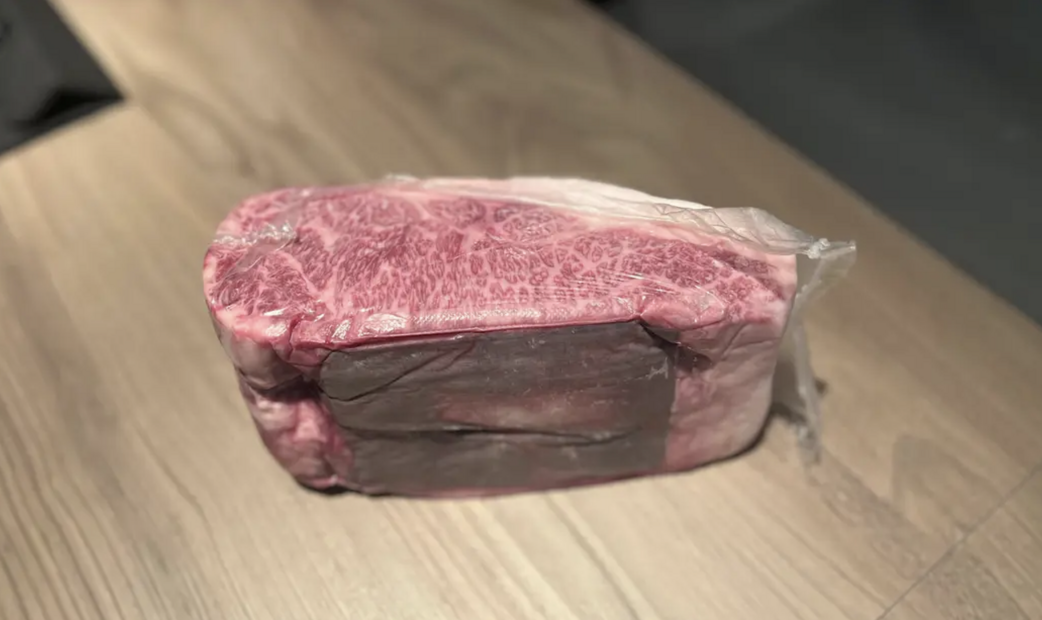
What Is Kobe Beef? We Asked a Steak Master in Tokyo
Celebrated as the pinnacle of Wagyu, Kobe beef enjoys a prestigious reputation around the world. In this article, we visit the renowned steakhouse IDEA Ginza, nestled in Tokyo’s upscale Ginza district, to speak with Chef Fujimoto—a seasoned expert with over a decade of experience working with Kobe beef. In a 1-hour and 40-minute in-depth interview, he shares insights into what makes Kobe beef the “world’s finest beef brand,” the sourcing process behind the scenes, the best ways to savor it, and stories of the exceptional producers who bring it to life.
- Discovering Kobe Beef at Its Finest: IDEA Ginza
- Defining Kobe Beef: Strict Certification Standards
- The Flavor Profile of Kobe Beef: Lean Meat and Fat
- Kobe Beef Certification: Individual Proof for Every Cow
- Kobe Beef at Its Best: Charcoal-Fired Steak in a Roasting Kiln
- Summary
- Kobe Beef Idea Ginza's Reservation
Discovering Kobe Beef at Its Finest: IDEA Ginza
IDEA Ginza is part of a restaurant group that originated in Kobe and has established a direct sourcing network with some of the region’s most respected Kobe beef producers. The restaurant has earned multiple spots on the Japan Restaurant Award’s Best 100 list and is celebrated for presenting Kobe beef at its absolute best. Executive Chef Fujimoto, a Kobe native, personally shared his deep knowledge and passion for this world-renowned delicacy.
Interview by: OMAKASE Editorial Team – Omori
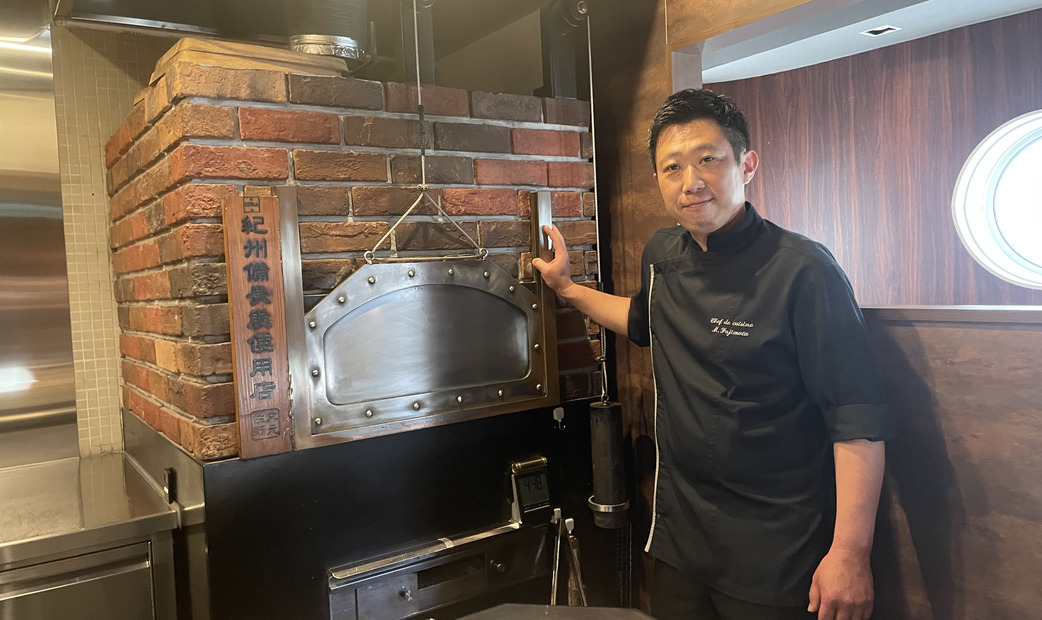
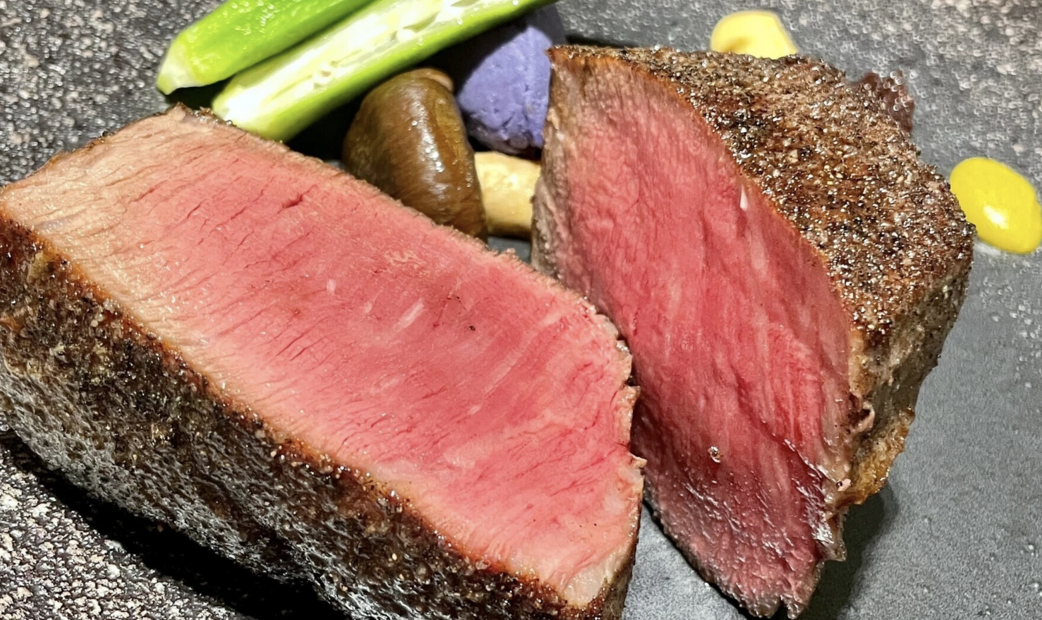
Defining Kobe Beef: Strict Certification Standards
What Determines an A5 Beef Ranking?
Interviewer Omori: Kobe beef is often called the finest beef in the world, even among the most prized Wagyu. But what exactly is Kobe beef?
Chef Fujimoto: Well, to begin with, there’s no such thing as a cow that’s born “Kobe Beef.” It all starts with Tajima cattle—a top-tier Wagyu bloodline. Only animals from that lineage, raised under very specific conditions, can be certified as Kobe beef.
Omori: So it’s not a breed, but more of a certification?
Chef Fujimoto: Exactly. Kobe beef certification comes down to three main things. First, it must be born, raised, and processed entirely within Hyogo. It also has to be a virgin female or a castrated male. Then, there are weight requirements: the carcass must be 499.9 kilograms or less—at least 270 kg for females and 300 kg for steers. And finally, the meat quality must rank between B4 and A5.
Omori: That’s a pretty specific set of conditions. And the size is quite a bit smaller than other Wagyu, right?
Chef Fujimoto: That’s right. Compared to breeds like Kagoshima or Miyazaki wagyu, which can weigh close to a ton, Kobe beef cattle are about half that. When you see one in person, it’s surprisingly small. Originally, Tajima cattle were largely used to carry the plow in the rice fields, so they naturally developed smaller bodies, fine muscle fibers, and delicate marbling.
Omori: I see. Now, about Wagyu grades like A4 and A5—how are those determined?
Chef Fujimoto: Wagyu is graded on two main scales. The first is yield grade, which runs from A to C. “A” means the cow produced a high amount of edible meat. The second is meat quality grade, from 1 to 5, which takes into account things like marbling, color, and fat quality. So, A5 means the highest yield and the best meat quality.
There’s also the BMS. BMS stands for Beef Marbling Standard. It’s a 12-point scale measuring the amount and quality of marbling. For Kobe beef, the BMS has to be between 6 and 12. If the BMS is 5 to 7, the yield grade is usually a B. If it’s 8 to 12, it’s typically an A.
Omori: So technically, a B4 or B5 with a BMS of 6 or 7 could still be considered Kobe beef?
Chef Fujimoto: Technically, yes. But in reality, B-grade cattle are pretty rare. Most certified Kobe beef ends up being from A-grade Tajima cattle.
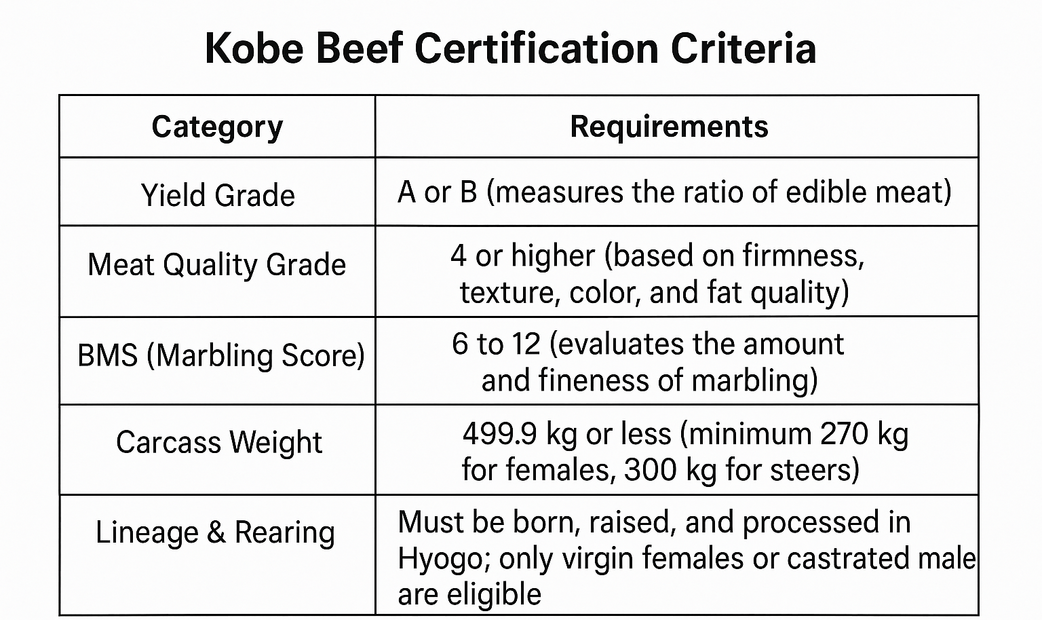
All of these criteria must be met for beef to be officially certified as “Kobe beef.” Unlike other popular Wagyu brands such as Matsusaka or Omi, which don’t impose strict standards on meat quality, marbling, or weight, Kobe beef stands out as the most rigorously certified Wagyu in Japan.
Yield Grade, Meat Quality – When Is Kobe Beef Certified?
Chef Fujimoto: At cattle auctions, the carcasses are split in half and hung up. A small section—about 4 to 5 centimeters—is cut from the rib area, and based on that, inspectors assess the overall quality of the meat. It’s similar to how tuna is judged at auction by examining a slice of the tail. That’s when they assign grades like A4 or A5. If the beef qualifies as Kobe beef, a chrysanthemum seal—the official flower of Hyogo—is stamped on each major cut, like the round or the loin.
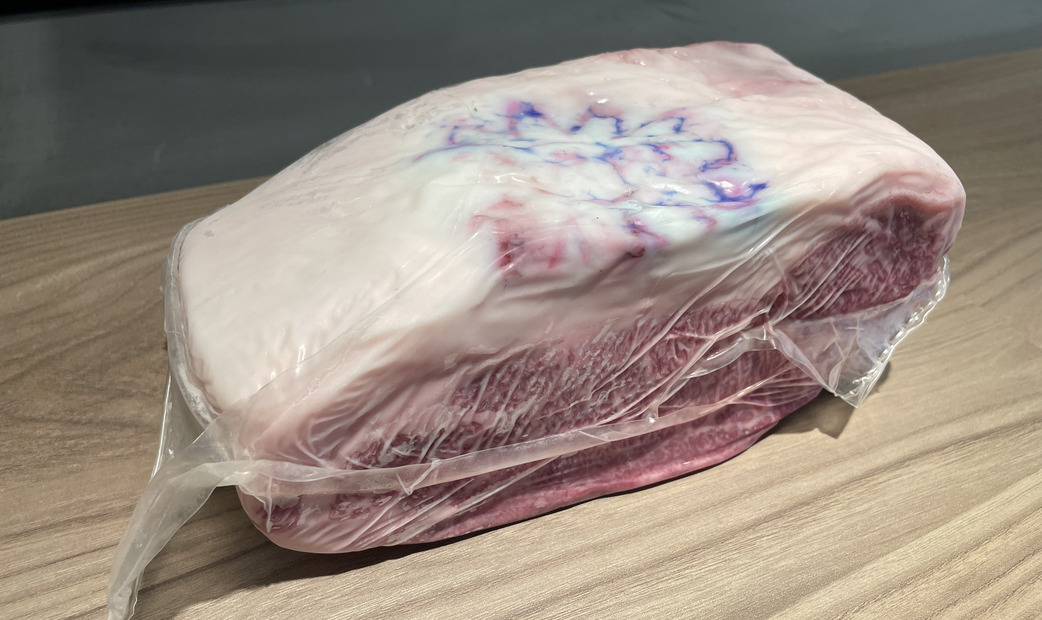
Chef Fujimoto: The auction takes place in a dedicated venue where carcasses are brought out one after another. An electronic display shows details like the producer, grade like A4, and the age of the cow. These days, you’ll also see something called “MUFA” on the screen. That stands for monounsaturated fatty acids, and the amount of oleic acid in the meat has become an important part of the grading criteria in recent years.
Omori: What’s oleic acid?
Chef Fujimoto: It’s a type of fat—technically an unsaturated fatty acid—that you also find in pork and chicken. Because it’s easier for the body to digest, it doesn’t leave you feeling heavy or bloated. It’s what people often refer to as “good” fat.
The Skill Level of Kobe Beef Producers Is Rising
Omori: These days, when farmers raise Tajima cattle aiming for Kobe beef certification, around 7,500 heads are officially recognized as Tajima cattle each year. Out of those, about 7,000 end up being certified as Kobe beef. I heard the certification rate is around 90%.
Chef Fujimoto: Yes, the percentage of Tajima cattle that qualify as Kobe beef has gotten incredibly high. When I first started my culinary career about 20 years ago, fewer Tajima cattle were being shipped out in general, and maybe only half—if that—met the standards to be called Kobe beef.
But it’s a different story now. The skills and expertise of the farmers have improved dramatically, and there’s a lot more information-sharing going on. People will say things like, “Ask this person,” or “Do it this way to meet certification standards,” and that know-how just keeps getting passed down within their networks.
Of course, the certification standards for Kobe beef are still considered among the strictest in the world. But today’s producers have risen to meet that challenge.
All Wagyu Traces Back to Tajima Cattle
Omori: I’ve heard that 99% of Japan’s Kuroge Wagyu cattle can be traced back to Tajima cattle and that 99% of those Tajima cattle come from a single legendary bull named Tajiri-go.
Chef Fujimoto: Yes, that bull likely lived in the early 1900s. He became the genetic origin of nearly all Kuroge Wagyu in Japan. From there, the breed known as Kuroge Wagyu started to spread nationwide. I believe Tajiri-go sired over 1,500 calves in just a little over a decade.

Tajima cattle have always been known for their outstanding meat quality, body structure, and stable growth. While most beef cattle breeds have a lot of crossbreeding, Tajima cattle were maintained under extremely strict bloodline control. Starting about a century ago, breeding bulls from Tajima were distributed to different regions, and that’s how Kuroge Wagyu took root across the country. And at the root of it all is Tajiri-go.
The Flavor Profile of Kobe Beef: Lean Meat and Fat
Omori: I feel like I now understand what defines Kobe beef and what makes it a brand. But how does it differ in taste or characteristics from other types of Wagyu?
Chef Fujimoto: When it comes to Kobe beef, what stands out is the softness of its fat. Normally, fat hardens when it's cold, right? But with Kobe beef, even after being chilled in the fridge a few times, it doesn’t get all that hard. Try touching it—you’ll see what I mean.
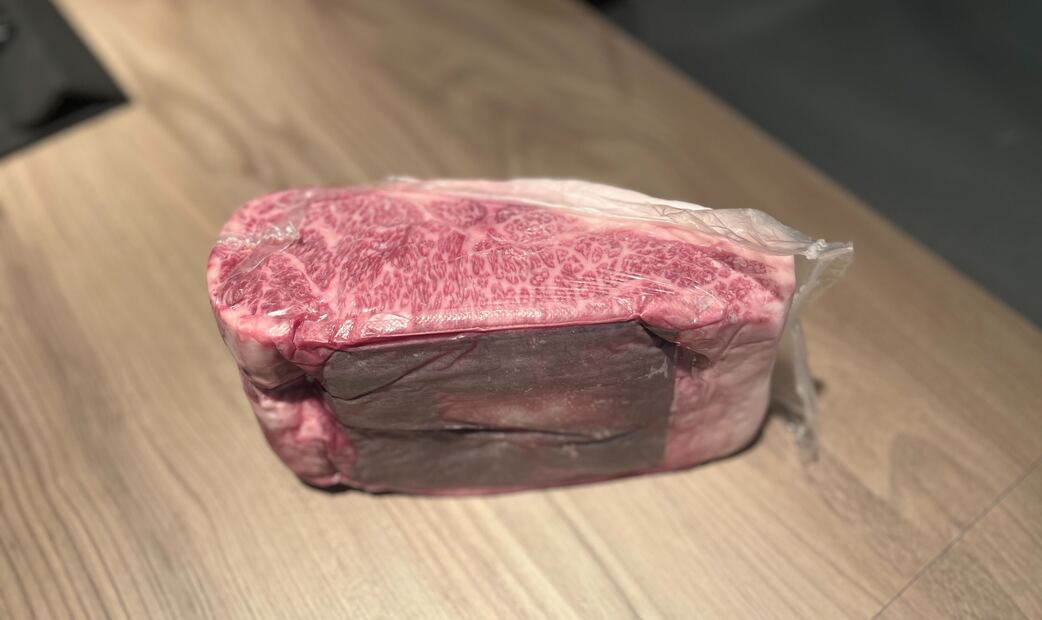
Chef Fujimoto: We trim the fat off and use just the marbled parts. Take a look at this sirloin—the marbling is super fine. We call that ko-zashi (delicate marbling).
Omori: Is that level of marbling finer than other types of Wagyu?
Chef Fujimoto: Much finer. And that’s what makes it incredibly delicious. When the marbling is this fine, it just melts in your mouth.
Let’s compare it with some Kuroge Wagyu from Hokkaido that’s not Kobe beef. The difference in marbling is clear. That difference directly affects the texture and how it melts when you eat it. So I’d say one of Kobe beef’s key traits is this ultra-fine marbling.

Chef Fujimoto: Then there’s the protein—the lean meat is also a big part of the appeal.
Omori: Is the lean meat noticeably different from other Kuroge Wagyu?
Chef Fujimoto: Definitely. The flavor is much deeper. One thing I’ve come to realize through my work is that, while people often talk about how great Kobe beef fat is, the best part is the balance between the fat and the protein. Even cuts like sirloin or Chateaubriand, which have a lot of fat, really bring out the deliciousness of the lean meat. I think that’s the signature trait of Kobe beef—the fat isn’t just there for richness, it enhances the flavor of the lean meat.
Kobe Beef Certification: Individual Proof for Every Cow
Omori: Can regular people like me buy Kobe Beef?
Chef Fujimoto: Generally speaking, it’s pretty hard to get your hands on it. You might find it at high-end department stores like Mitsukoshi, or in Kobe itself—there are plenty of specialty butcher shops there that deal exclusively in Kobe beef. But in a typical Tokyo supermarket? It’s extremely rare. Even if you see something labeled “Kobe beef” at a supermarket, you might wonder, Is this the real thing? That’s because Kobe beef puts a lot of emphasis on maintaining its brand integrity and trust.
Omori: And real Kobe beef comes with an official certification mark and an individual ID number, right?
Chef Fujimoto: That’s right. Each cow has its own set of documents—proof that it’s a certified Tajima cow, proof that it qualifies as Kobe beef, and an individual identification number. There’s even a pedigree, registered when the calf is born, that traces its lineage back several generations: the father, mother, grandparents, and even great-grandparents. They also include a nose print to uniquely identify the animal—kind of like a fingerprint.
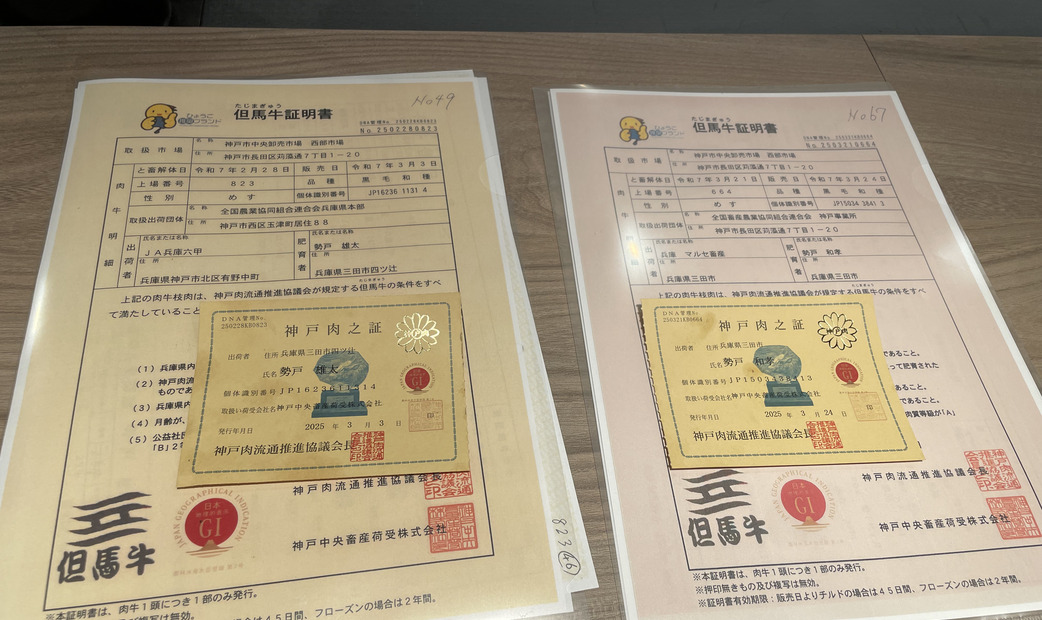


IDEA’s Beef Supplier: The Remarkable Mr. Seto
Omori: I see the producer’s name is listed here too. Did this Kobe beef come from Mr. Seto?
Chef Fujimoto: Yes, and to give you a bit more background—Mr. Seto is well-known in the industry. When it comes to raising female cattle, he’s probably the best in the business. He only raises females. For our restaurant’s sirloin, we use beef exclusively from Mr. Seto.
Other farmers also specialize in female cattle, but his methods are on another level. He’s very particular—even about the size of the cows. Kobe Beef certification allows for cattle between 270 and 499 kilograms, but he keeps his cows on the smaller side, around 300 kilos.
Omori: Why does Mr. Seto’s beef taste better than others?
Chef Fujimoto: I’d say it’s probably the feed. I don’t know the exact mix he uses, but I’m sure he has a deep understanding of how different feed combinations affect the growth and flavor of the meat. He must have a finely tuned routine based on years of experience.
Omori: How rare is it to get beef from Mr. Seto?
Chef Fujimoto: Honestly, I doubt many restaurants in Tokyo can get their hands on it. Even top-tier steakhouses and well-known spots in the city probably can’t source beef from him. We’re incredibly lucky to have it—it’s something we’re proud of.
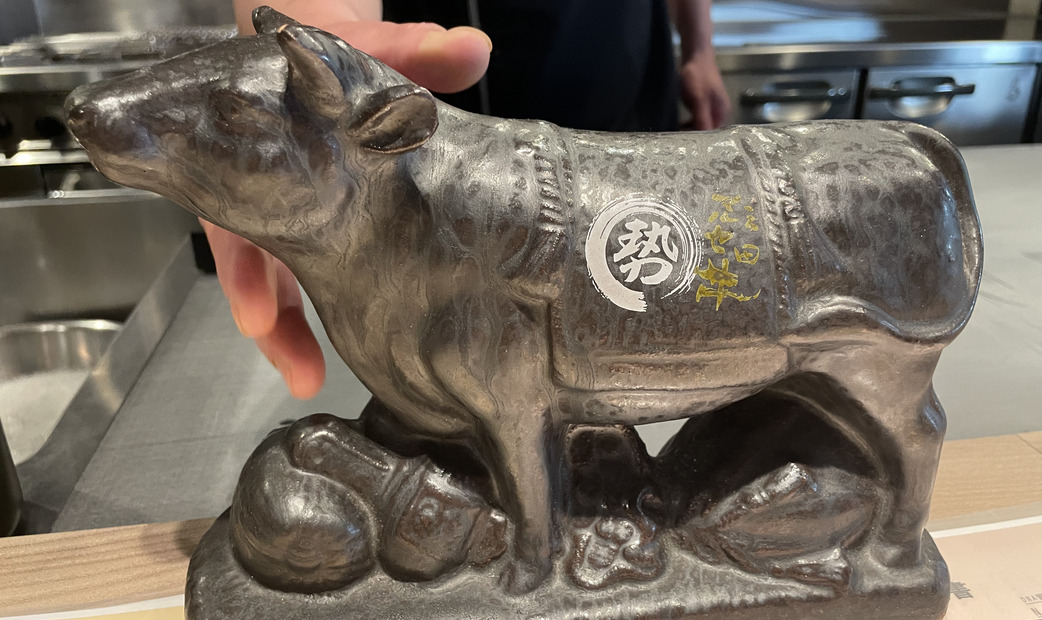
The Sourcing and Pricing of Kobe Beef
Omori: How do you go about sourcing Kobe beef?
Chef Fujimoto: Basically, it’s done through auctions. Wholesalers bid at these auctions, and restaurants like ours purchase from them. Most of the Kobe beef auctions happen in the Kansai region. Of course, some buyers from the Kanto region—like Tokyo—also attend, but the majority are Kansai-based dealers.
For restaurants in Kanto to get Kobe beef, they typically need to go through a Kanto-based supplier who’s connected with someone in Kansai. That makes it either very difficult to source or significantly more expensive.
Omori: So how is IDEA able to get it?
Chef Fujimoto: Our company is originally based in Kobe, so we’re able to source it directly from there. That gives us a big advantage—we can buy it at a lower cost compared to most Tokyo restaurants. Most of the time, we work directly with wholesalers who win the auction bids. Occasionally, we’ll do something called a "direct deal," where we purchase directly from a producer, but that only happens a few times a year.
Omori: Is Kobe beef much more expensive than other types of Wagyu?
Chef Fujimoto: Take a look at this—it’s price data from a March auction. For Tajima female cattle, the price per kilo of dressed carcass—including bones—was around 3,836 yen. That’s not outrageously high. But if you compare it to Wagyu from other regions, some places are under 2,000 yen per kilo.
Omori: So Tajima cattle can cost 1.5 to 3 times more than Wagyu from places like Miyazaki?
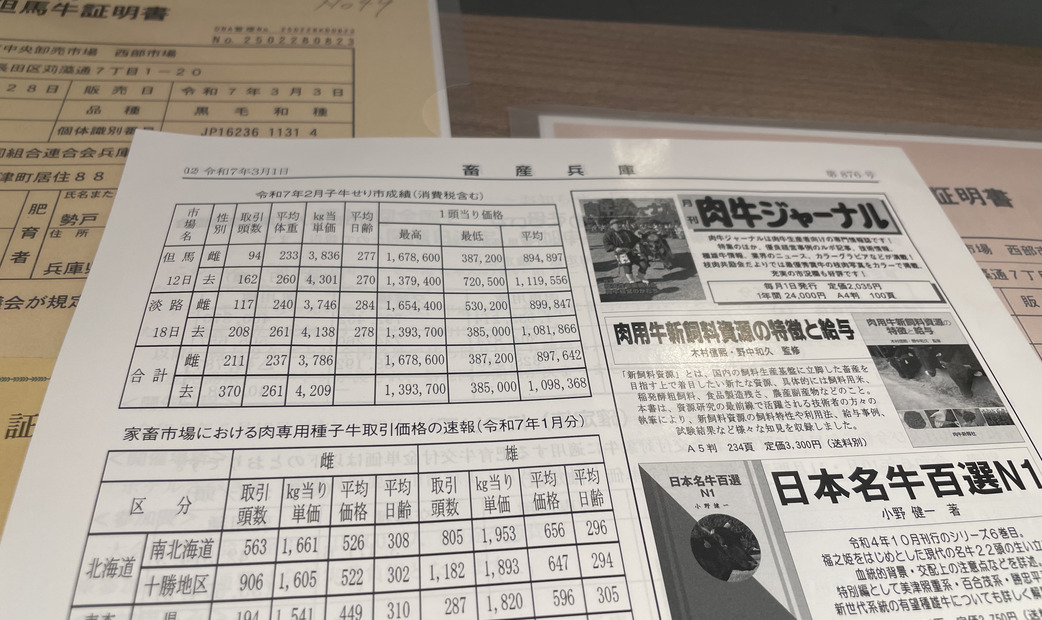
Chef Fujimoto: Exactly. And the auction schedule for Kobe beef is publicly available.
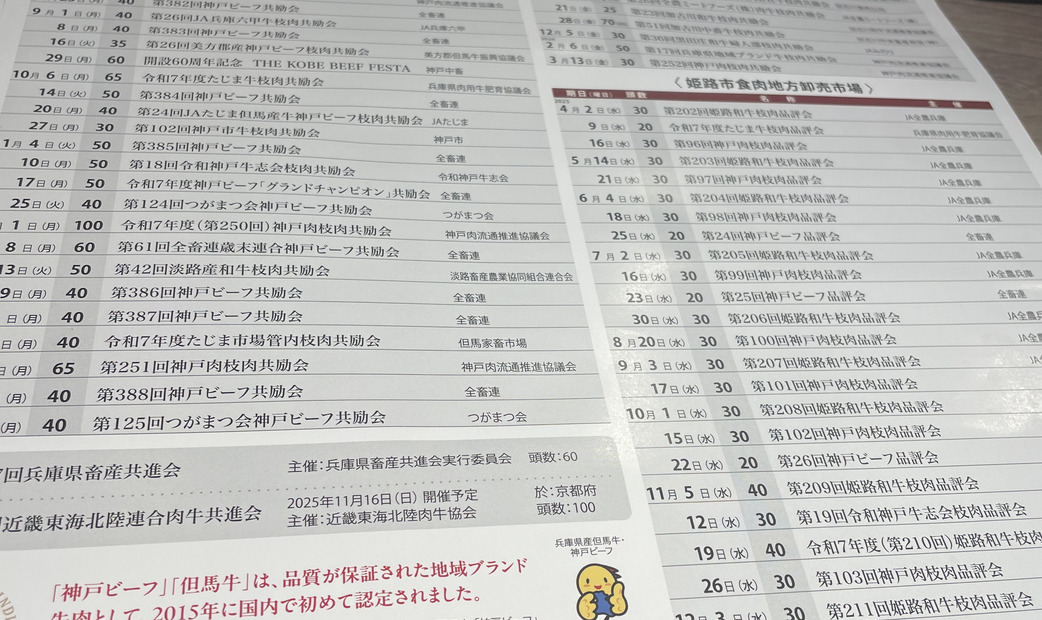
Omori: It appears they are held about four times a month. Are there any differences between the auctions?
Chef Fujimoto: Yes—some auctions, particularly those with a larger number of cattle up for bid, become major events. Producers schedule their shipments to align with these. When an auction becomes intense, prices can soar. A carcass that typically sells for 3,800 yen or 4,000 yen per kilo can suddenly escalate to 12,000 yen.
Omori: 12,000 yen per kilo?! That’s astonishing.
Chef Fujimoto: It really escalates. Typically, bidding starts around 3,500 yen, but for something like a “Champion Cow,” the opening bid might be 7,000 yen. Then someone raises it to 8,000 yen, then 9,000 yen, then 10,000 yen… and it just continues.
Kobe Beef Overseas: Is It the Real Deal?
Omori: Kobe beef seems to be even more popular overseas than in Japan. But is the Kobe beef being sold abroad actually authentic?
Chef Fujimoto: For many people overseas, any well-marbled Kuroge Wagyu gets labeled as “Kobe beef.” That’s still a pretty common misconception. Lately, more accurate information is spreading, so people are starting to understand the difference. But honestly, a lot of what’s marketed as Kobe beef abroad is probably just regular Kuroge Wagyu.
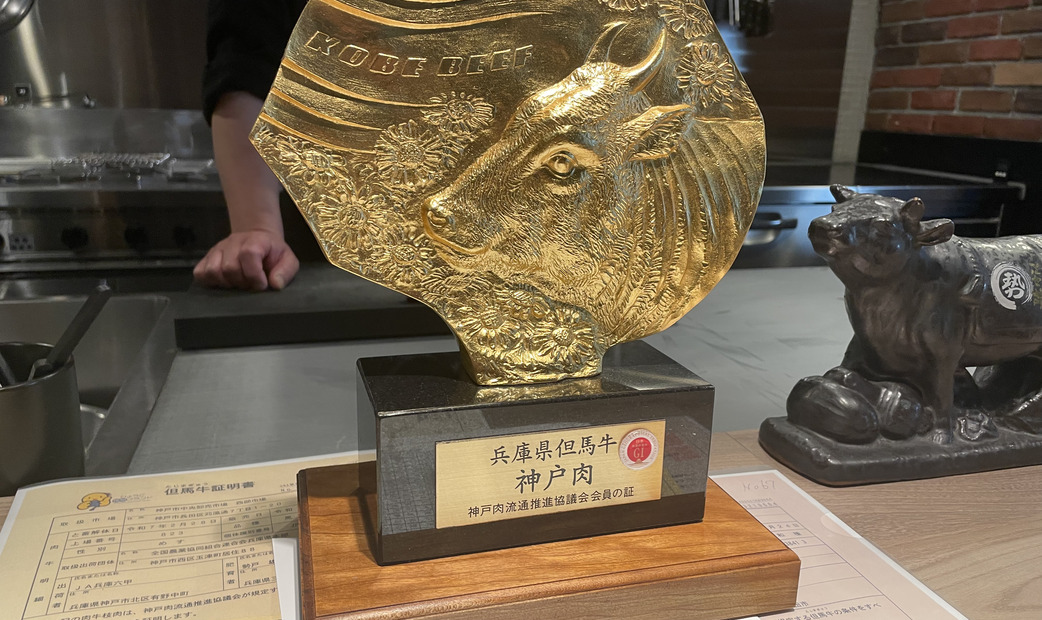
Kobe Beef at Its Best: Charcoal-Fired Steak in a Roasting Kiln
"The Best in the Galaxy": Sano’s Binchotan Charcoal
Omori: One of the standout features of IDEA’s restaurant is how you cook your top-quality Kobe beef—not on a teppan or in a frying pan, but using binchotan charcoal in a custom kiln. Can you tell us more about the kiln and the charcoal?
Chef Fujimoto: We use only Kishu Binchotan, specifically from a producer named Mr. Sano. It’s the only charcoal we’ll use.
Omori: Is there that much difference between types of binchotan?
Chef Fujimoto: Absolutely. Mr. Sano’s binchotan is, honestly, the best in the galaxy. It’s made only at his kiln. Regular charcoal contains trace impurities—even if it’s 99.9% carbon, those impurities can cause it to crackle or pop when burning. But Mr. Sano’s binchotan is incredibly pure—just solid carbon. It burns evenly, silently, and cleanly.
Each piece is custom-cut to our specs and packed in boxes before being shipped to us. We went to Wakayama over 13 years ago to ask Mr. Sano personally if we could use his charcoal. Ever since IDEA Group has had an exclusive relationship with him. These days, I doubt anyone new could even get access to his charcoal.
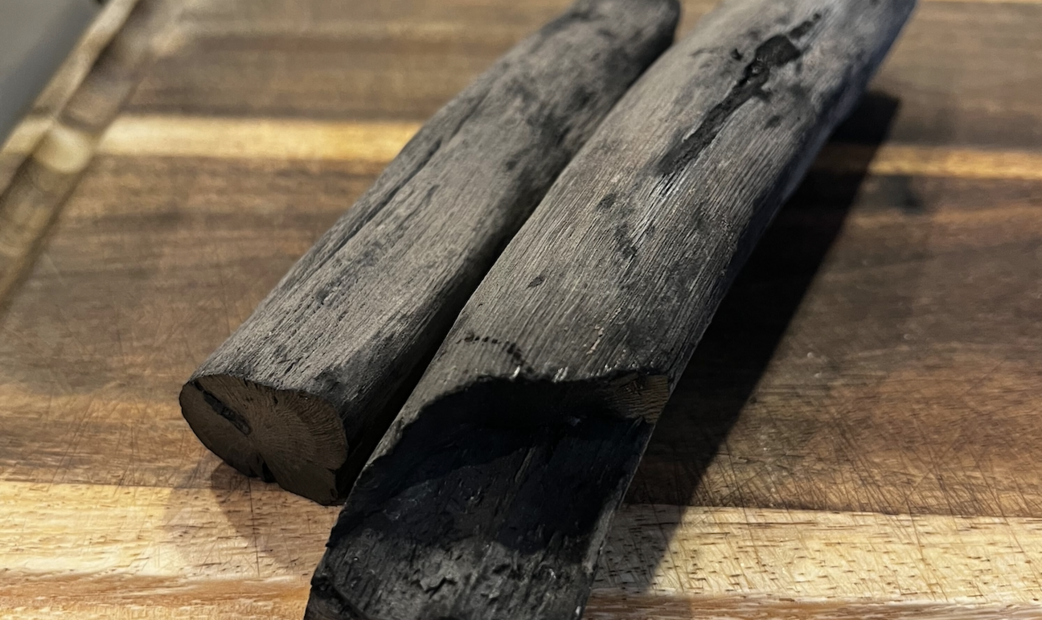

The Best Way to Cook Sirloin: Kiln-Roasting
Omori: Can you tell us more about kiln-roasting?
Chef Fujimoto: Certainly. Kiln-roasting involves skewering the meat and roasting it inside a brick oven. Unlike cooking on a grill or in a pan, kiln-roasting provides a nice, even cook to the meat. The exterior becomes beautifully crisp, and the excess fat drips away during the cooking process.
Omori: Why does kiln-roasting produce that kind of finish?
Chef Fujita: A kiln functions somewhat like an oven. The front is slightly cooler, while the back becomes hotter. There is space below the charcoal, allowing air to be drawn in from underneath. This creates natural airflow, circulating heat throughout the kiln. Additionally, the radiant heat from the charcoal reflects off the bricks, enveloping the meat from all directions.
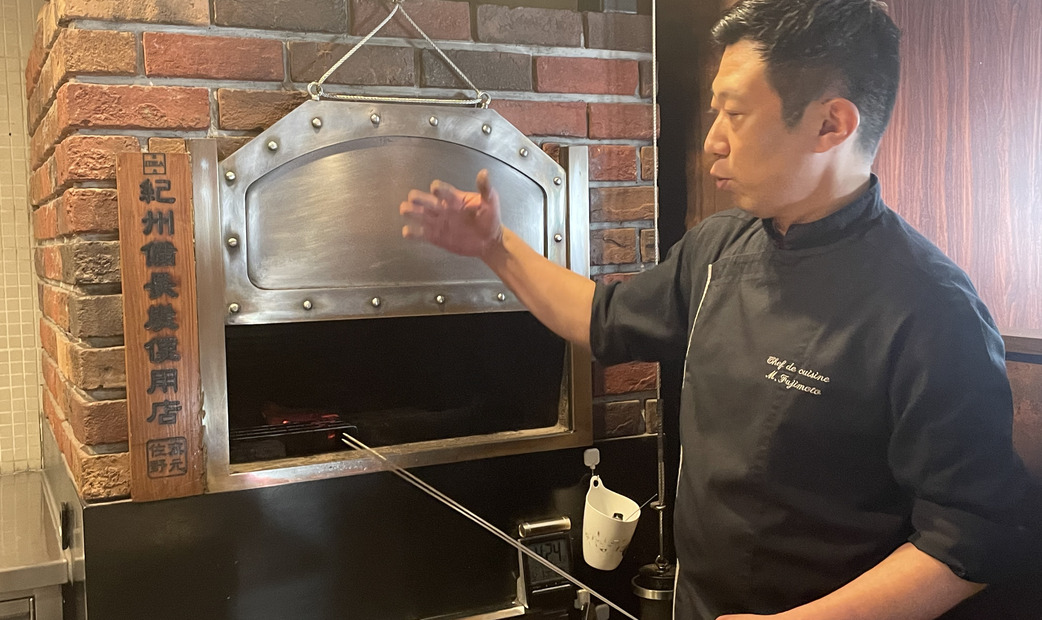
Chef Fujita: When we're cooking larger cuts of meat, we sometimes stand them upright inside the kiln. That way, even rich cuts like sirloin shed more of their fat as they roast. With a pan or iron grill, the meat tends to sit in its fat, which can make it feel heavy. That’s why sirloin often gets a reputation for being too rich. But with kiln-roasting, the fat drips off, and the result is something entirely different. You’ve got to try it.
Omori: So for people who love flavorful, fatty sirloin but find it a bit too heavy, this is the perfect cooking method.
Chef Fujimoto: Exactly. That’s why, when it comes to kiln-roasting, I think fatty cuts like sirloin are the most delicious. I believe sirloin truly shines the most in this style of cooking.
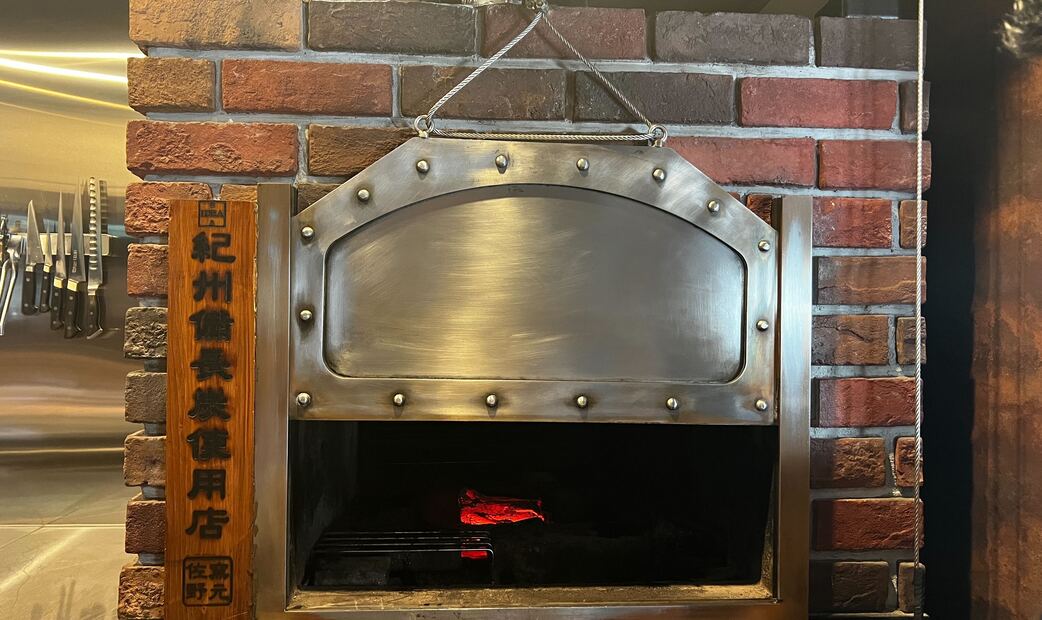
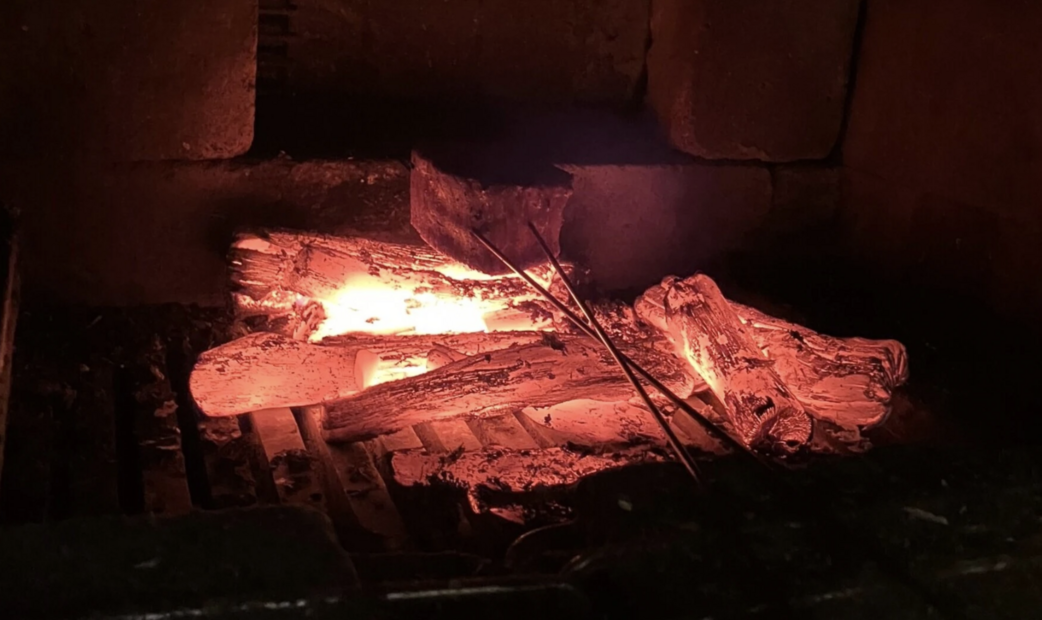
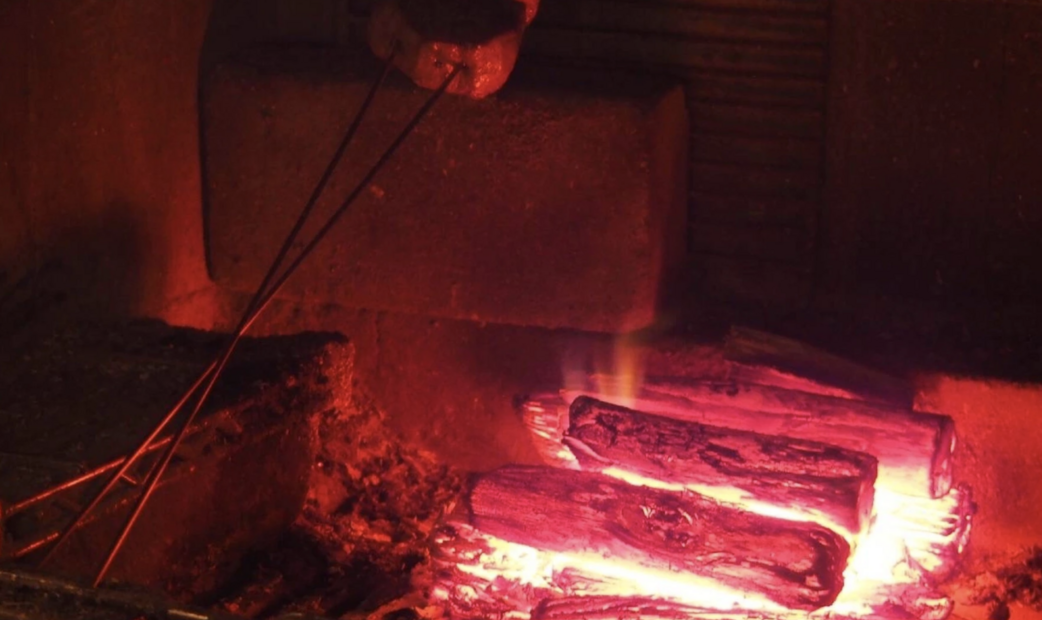
The Secret to Steak: Season Before You Grill
Omori: Do you have any personal techniques or preferences when it comes to cooking steak?
Chef Fujimoto: I always season the meat with salt and pepper before I cook it.
Omori: Oh, so you season it beforehand?
Chef Fujimoto: Yes. In French or Italian cuisine, and even at many steakhouses, they usually season after cooking. That method makes sense—it's easier to control the final flavor. But I prefer to season ahead of time, imagining that some of the salt and pepper will fall off during cooking. So I season a bit generously from the start.
Omori: What’s the benefit of seasoning before cooking?
Chef Fujimoto: Salt is made up of crystals, and when it cooks together with the fat from the meat, it binds and creates a deeper flavor. As for black pepper—surprisingly, around 66.7% of it is sugar. That sugar caramelizes during cooking, giving the meat a nice aroma and flavor. Pre-seasoning also helps create that crispy crust on the surface.
Omori: So that method pairs especially well with the kiln-grilling technique?
Chef Fujimoto: Exactly. If you're using a kiln like we do, seasoning before grilling brings out the best in the steak.
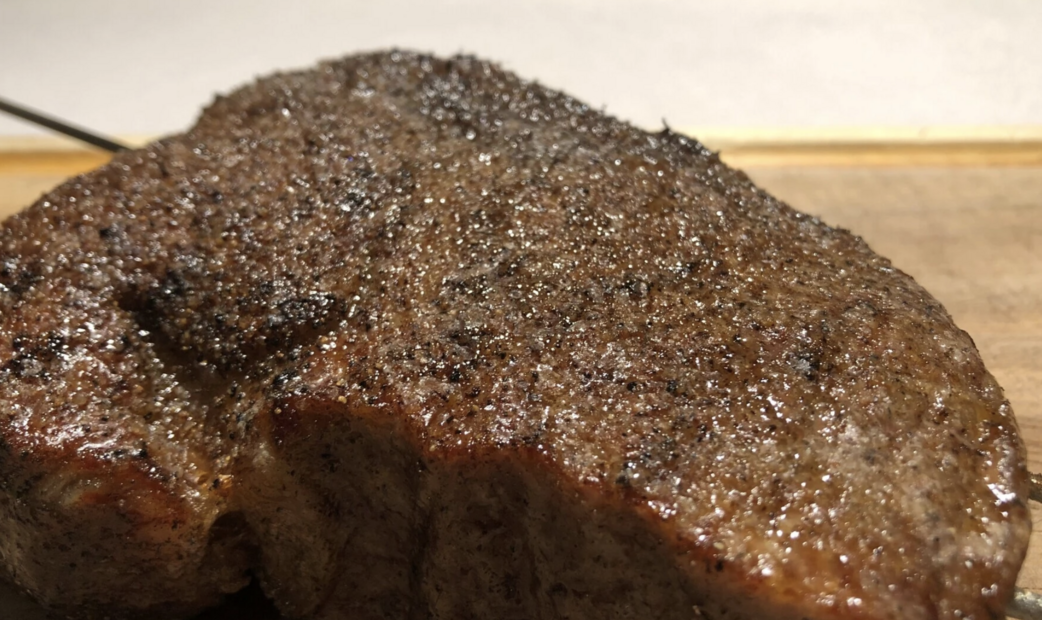

What to Order: The Best Way to Enjoy Kobe Beef Sirloin
Omori: Is there a must-try dish at your restaurant? I assume Chateaubriand is the top choice?
Chef Fujimoto: While Chateaubriand is the most expensive cut, I still say sirloin is the one you absolutely have to try. Absolutely. We don’t even offer the sirloin course on other reservation platforms—only through OMAKASE.
Omori: Chateaubriand is incredibly popular too, so why do you recommend sirloin over it?
Chef Fujimoto: Chateaubriand is delicious, no doubt, and it's great with other cooking methods. But if you’re going to enjoy a steak cooked in our binchotan-fired kiln, sirloin is the best cut. It’s rich in flavor, and the fat becomes light and pleasant thanks to the way it’s cooked. When I eat sirloin grilled on a regular iron plate or pan, even I find the fat a bit heavy. But kiln-roasting lets the excess fat drip away, leaving just the delicious flavor. I truly believe this is the best way to enjoy sirloin!
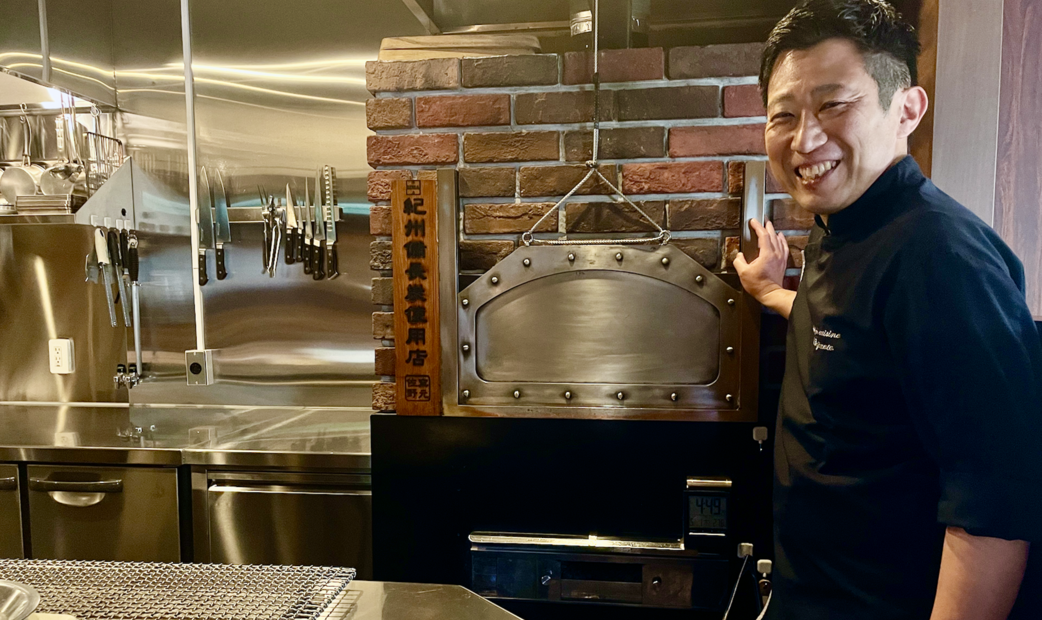
Summary
Kobe beef is one of Japan’s most strictly certified types of Wagyu, known for its exceptional balance of marbling and lean meat. Its flavor and texture set it apart—even among premium Wagyu. True Kobe beef rarely appears in standard supermarkets, either in Japan or abroad, and when it does, it comes at a premium price.
At IDEA Ginza, thanks to their direct supply network from Kobe, you can enjoy cuts that aren’t available anywhere else in Tokyo—including beef from the renowned producer Mr. Seto. The restaurant is so well-known that international visitors often outnumber local diners.
If you’re visiting Tokyo and want to experience Kobe beef at its finest, try the sirloin steak at IDEA Ginza. Reservations are available through OMAKASEJE.
Kobe Beef Idea Ginza's Reservation
- Operation hours
- Lunch: 12:00 PM - 2:00 PM (Tue-Sat)
Dinner: 6:00 PM - 11:00 PM - Regular holiday
- Sundays, Irregular Holidays
- Price range
-
Lunch: USD 65.22 - USD 81.53
Dinner: USD 160.22 - USD 467.2 - Address
- 7F Shimbashi kaikan,7-8-5, Ginza, Chuo-ku, Tokyo
- Nearest station
- Ginza Station, Shimbashi Station
- Directions from station
- 5 minutes walk from Ginza Station
5 minutes walk from Shimbashi Station - Payment methods
- Cash, Credit card available
- Seats
- 20 Seats
- Awards
-
Awards
-
Ilias4.8Posted on :04/24/2025
-
Dudley Elliott5.0Posted on :04/11/2025
-
KaiK4.7Posted on :01/07/2025
*English menu available at the restaurant

